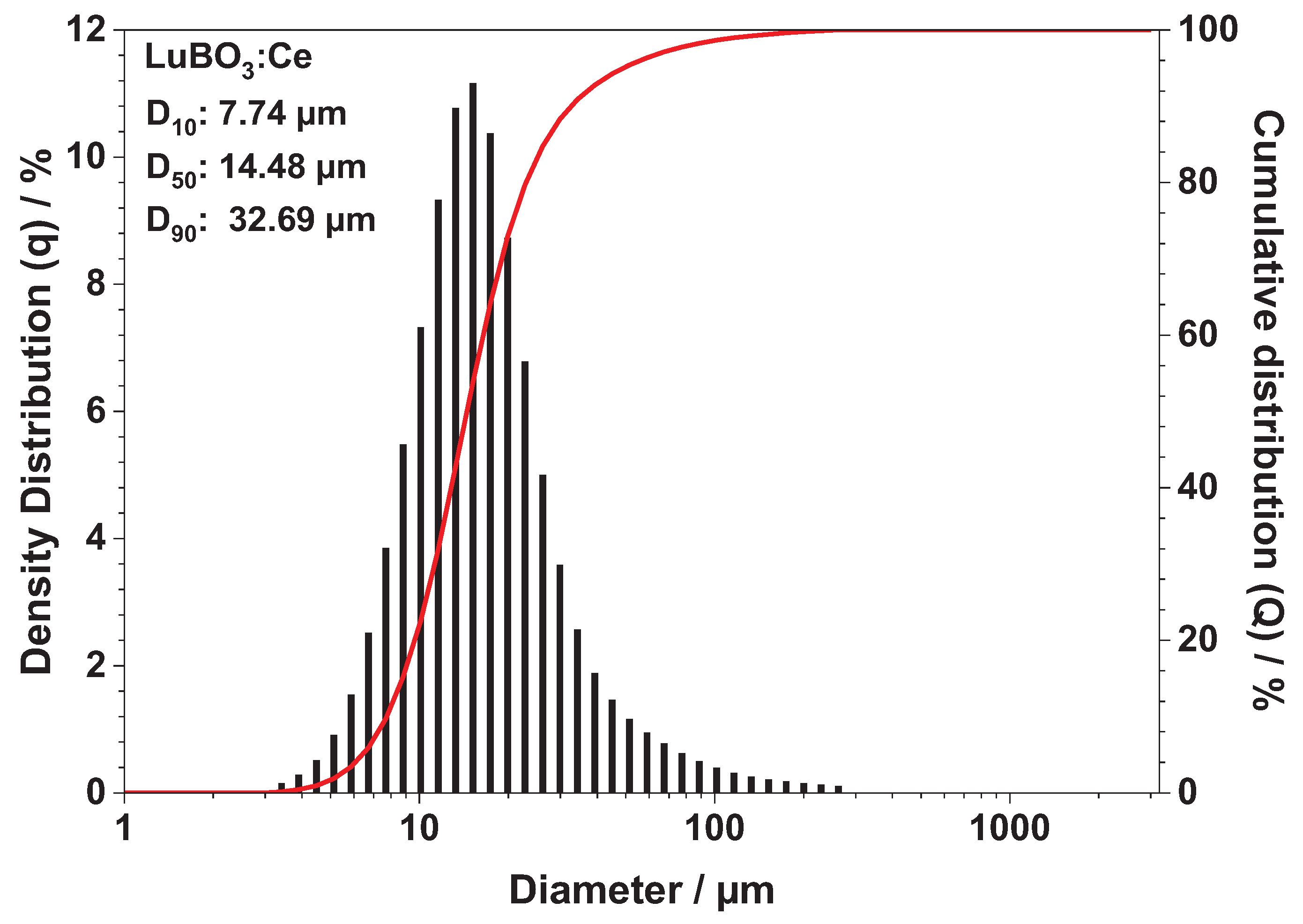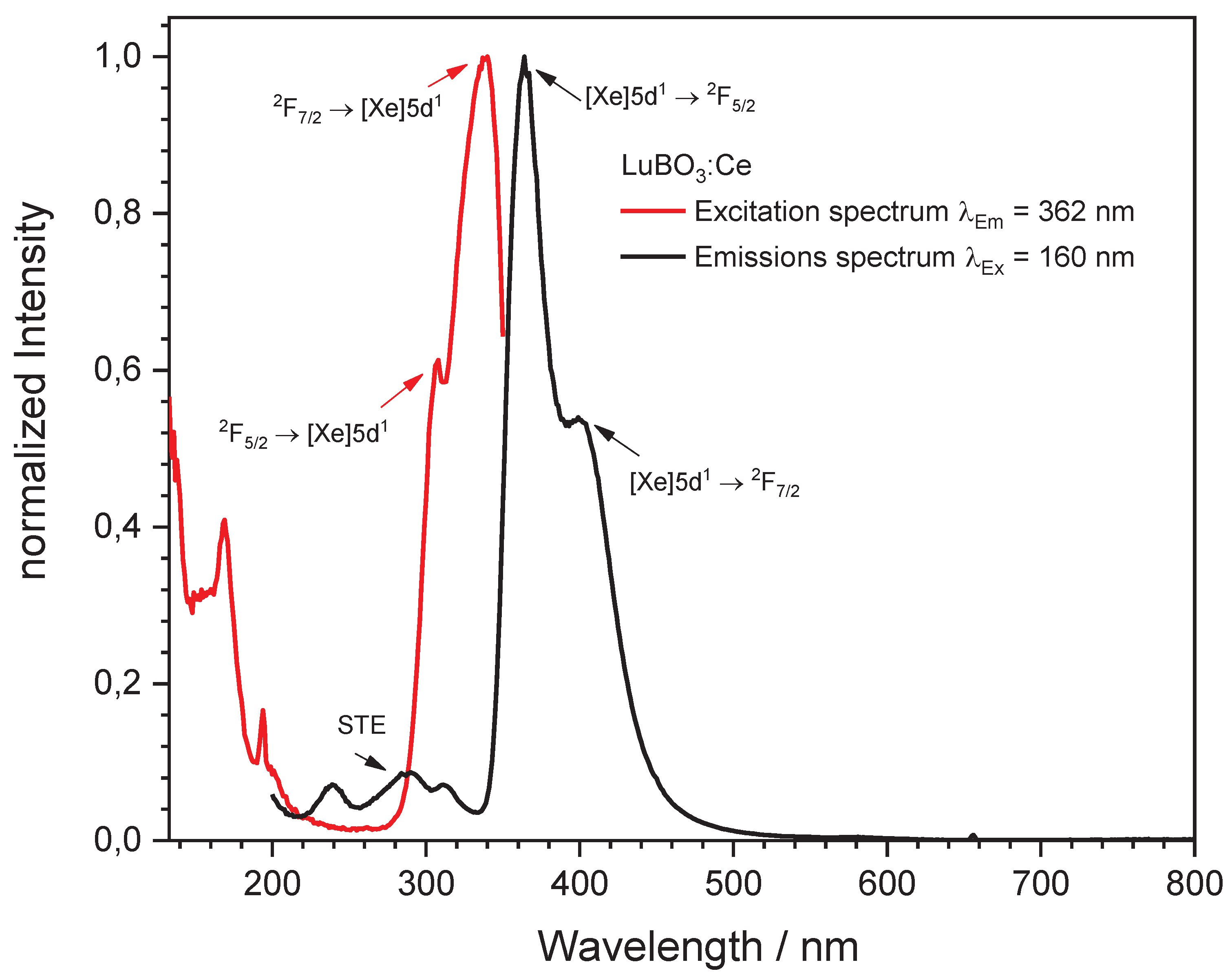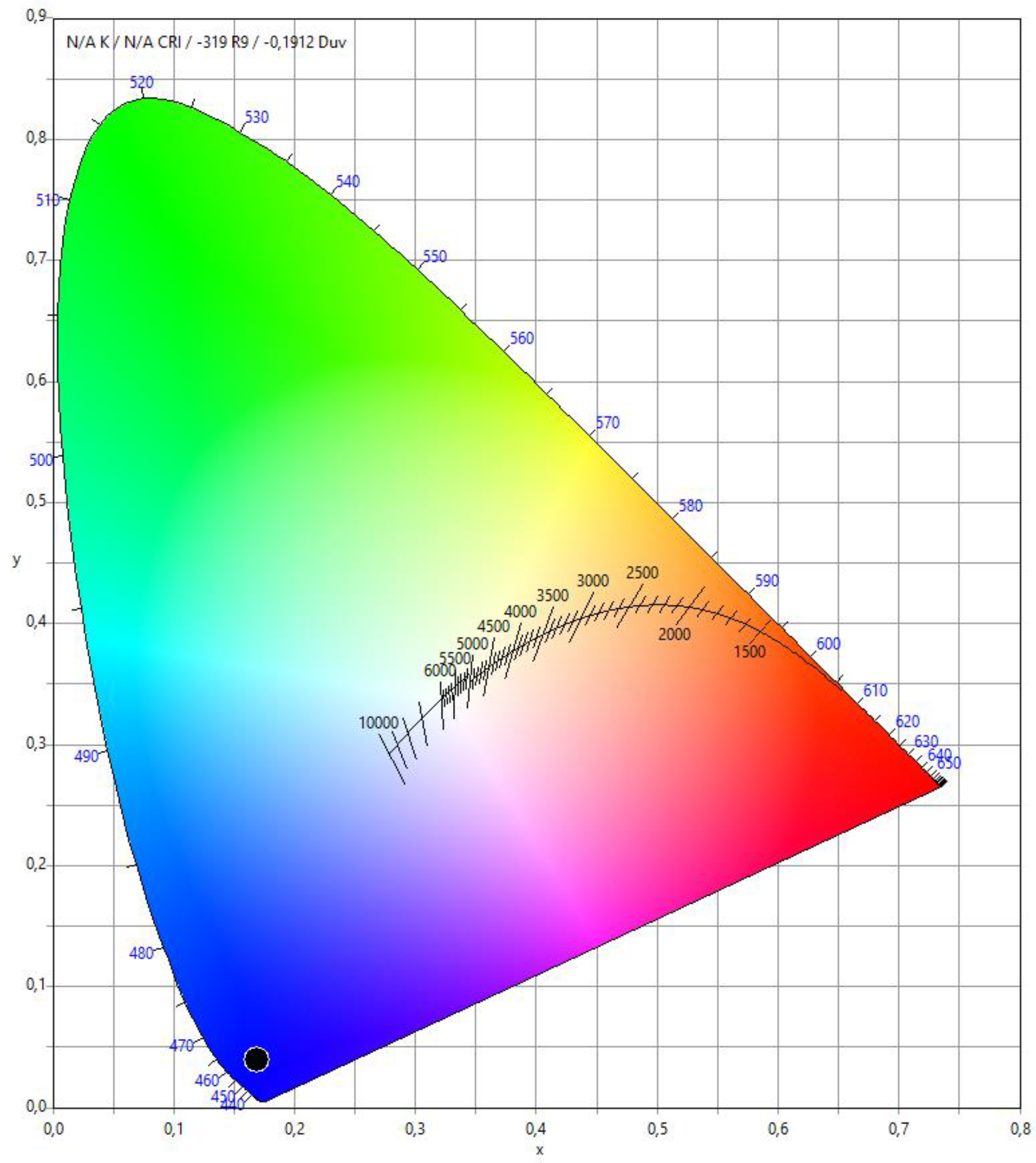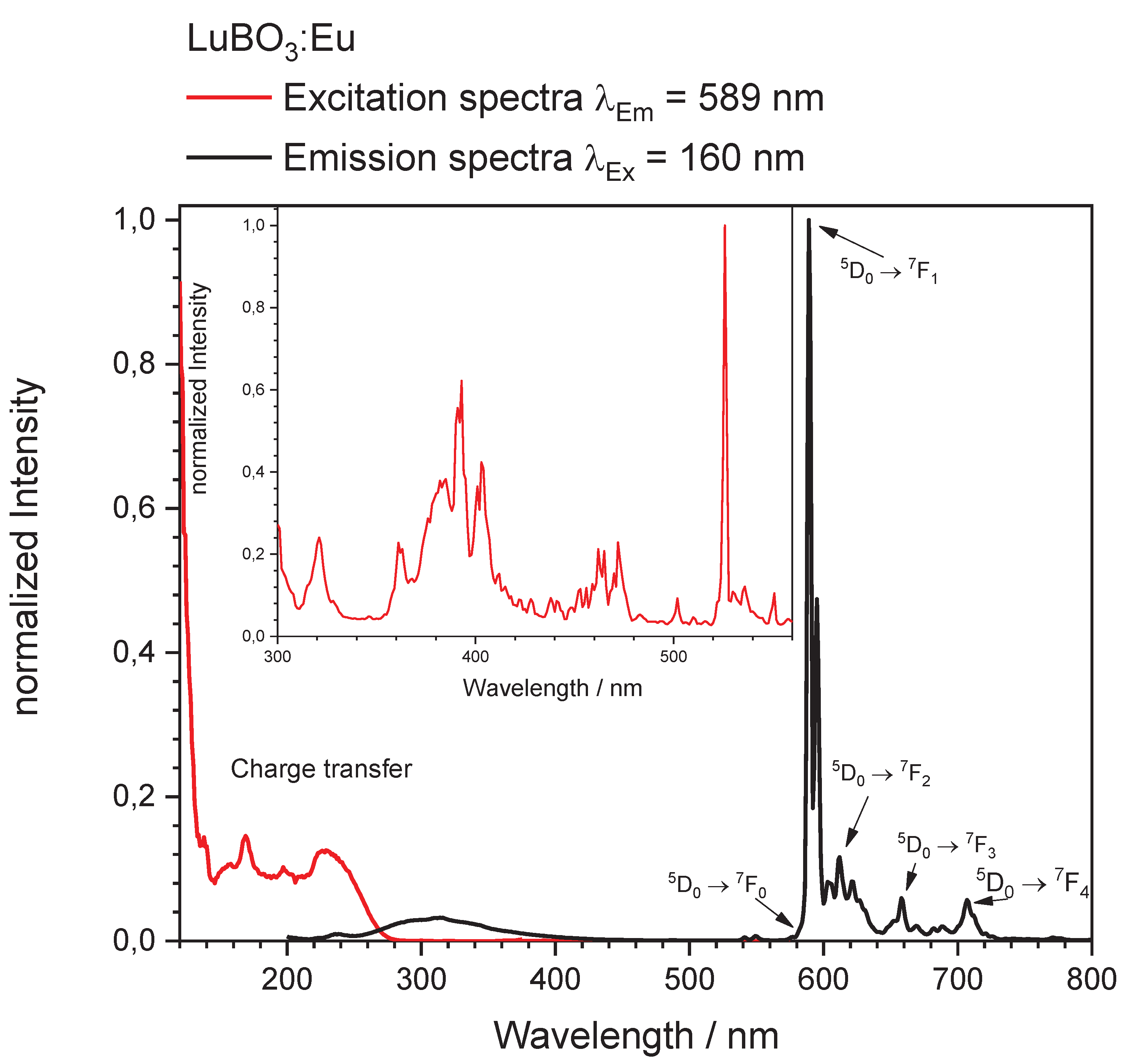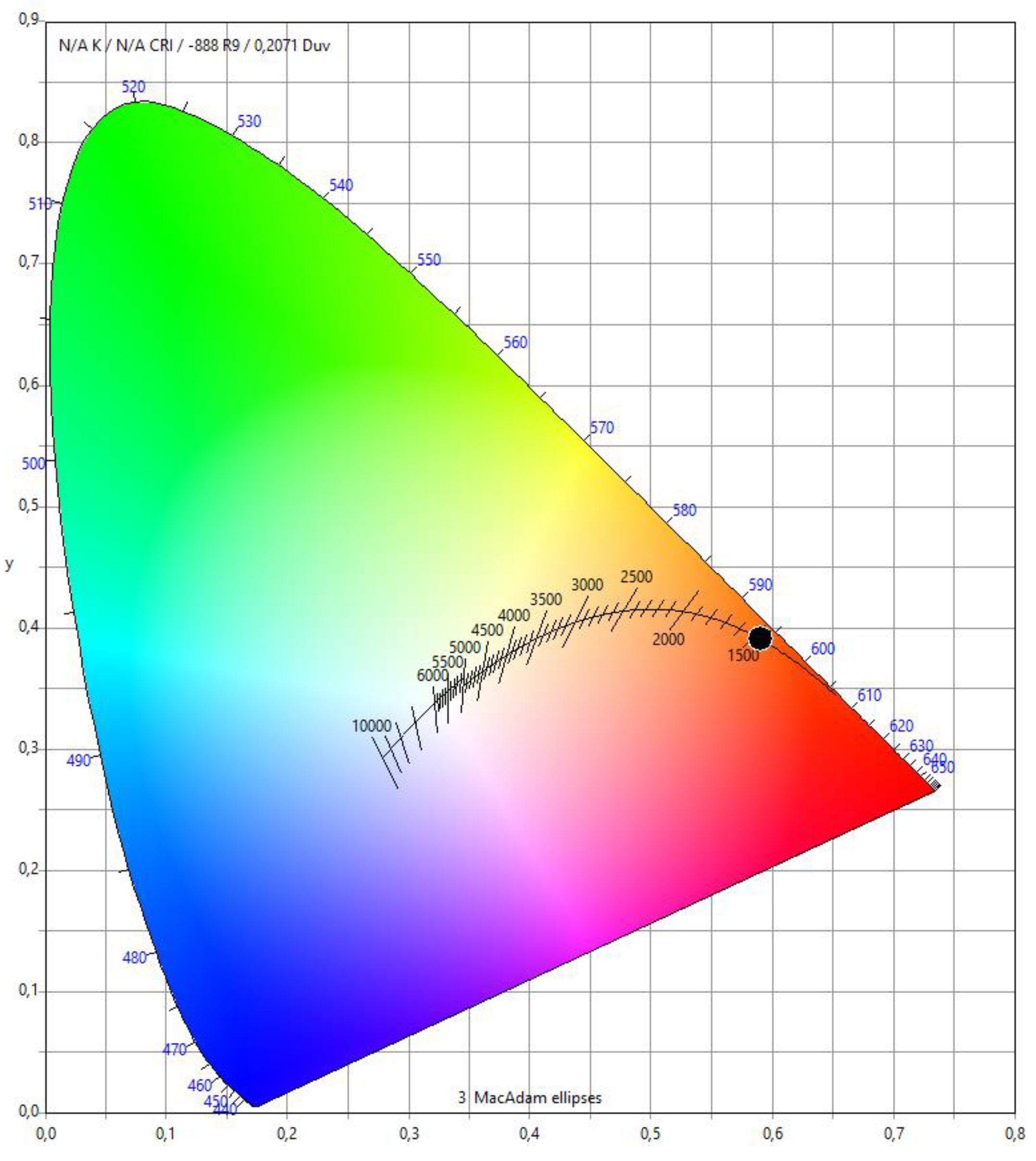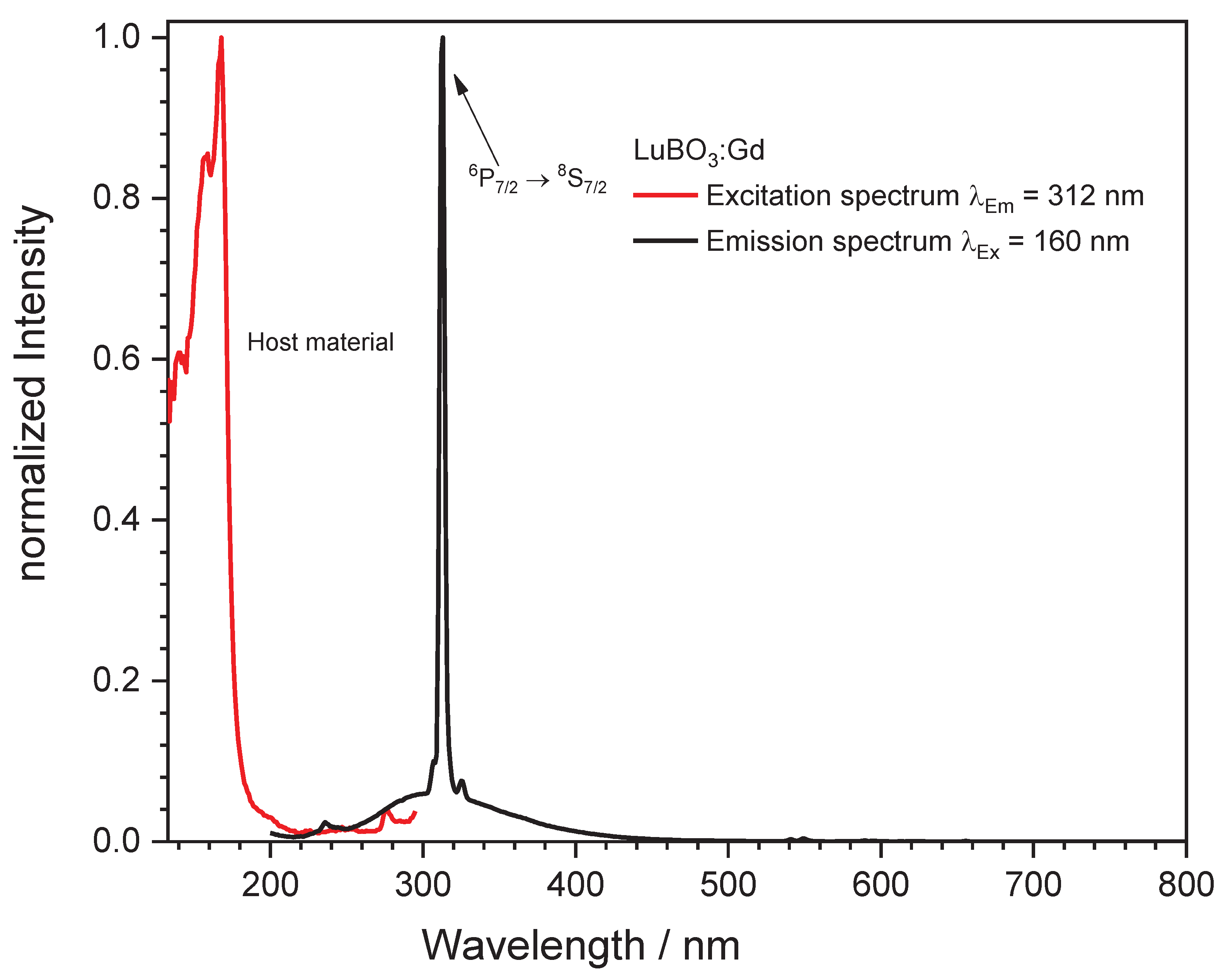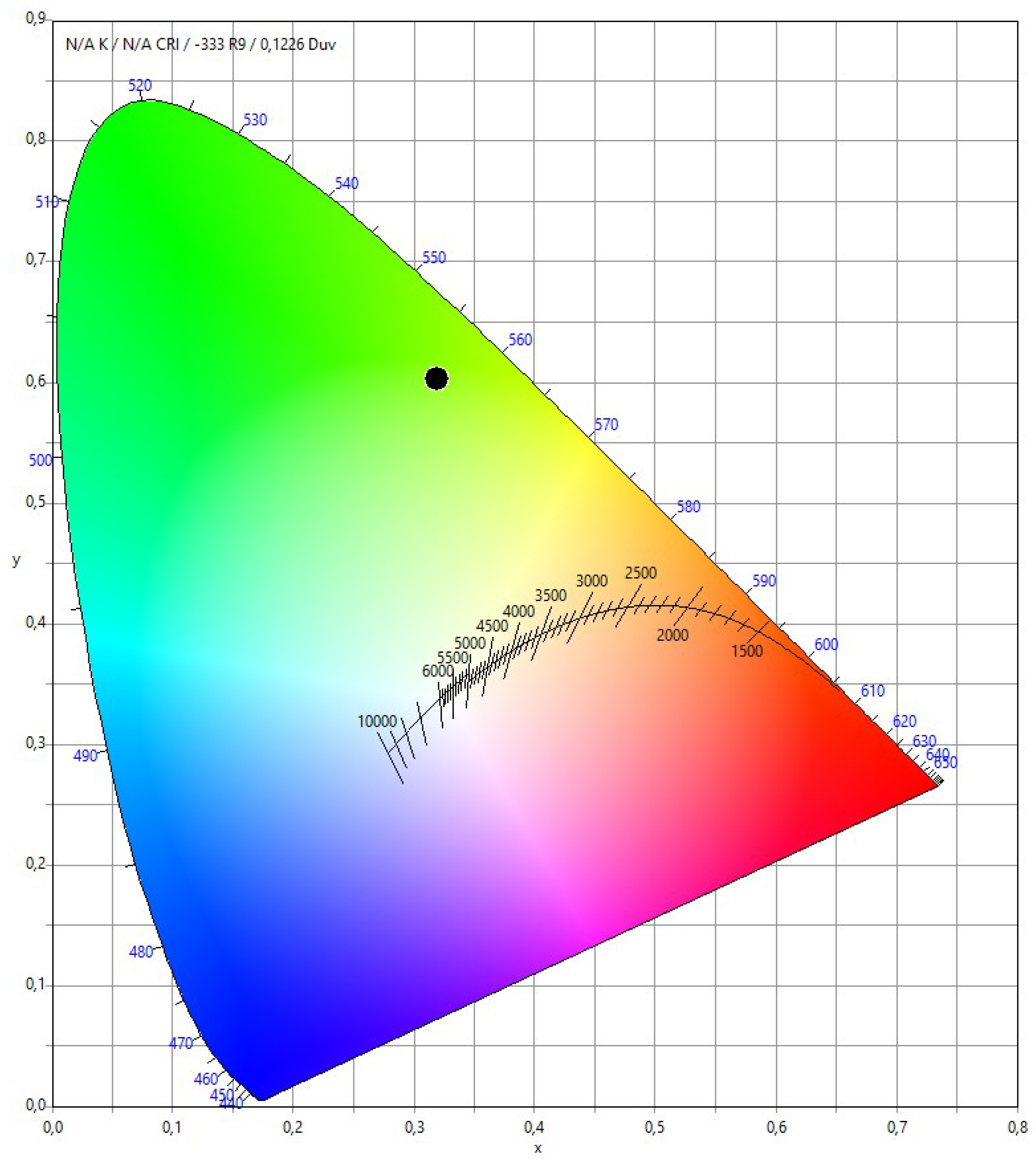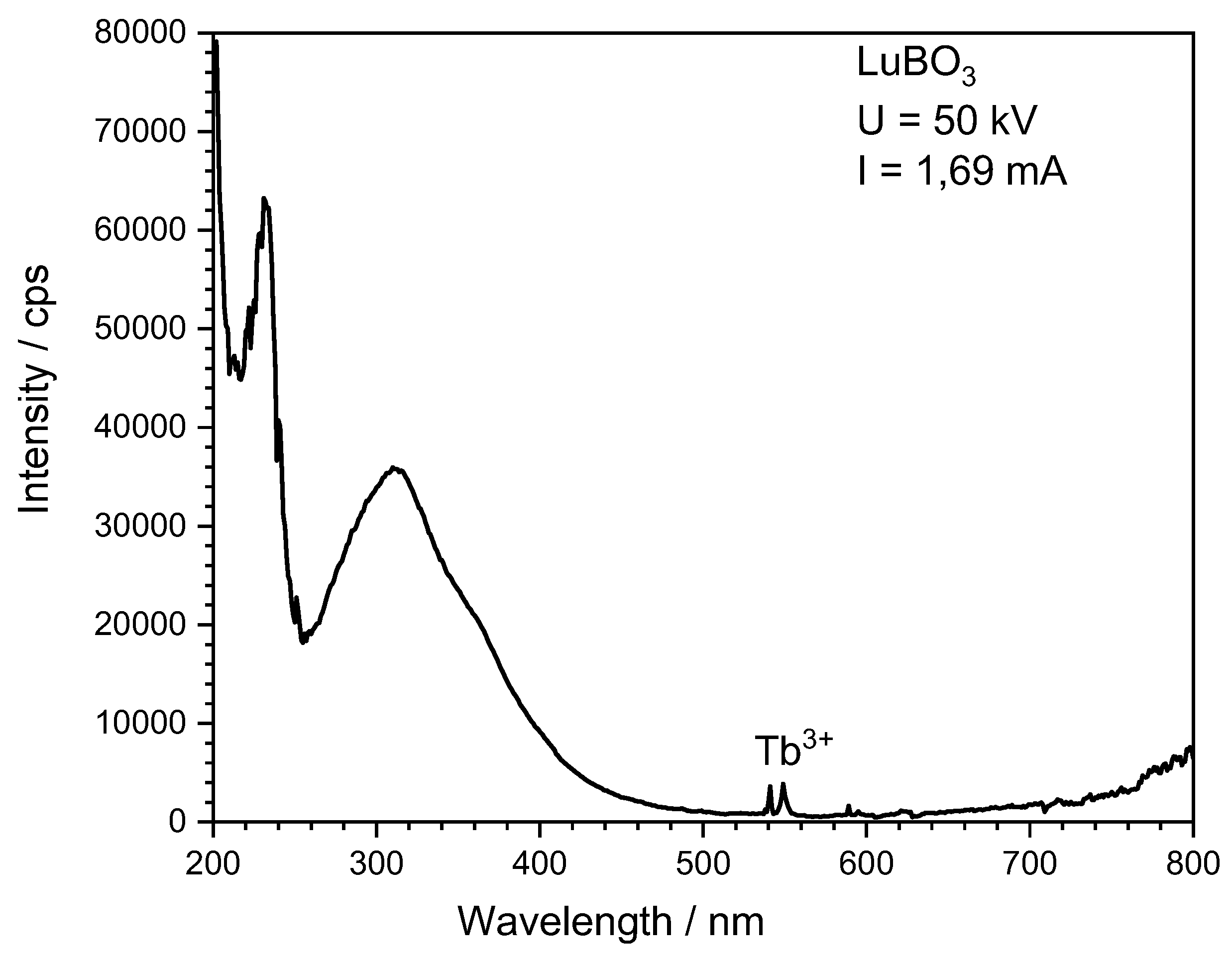1. Introduction
For many decades, rare earth orthoborates REBO
3 have been of tremendous scientific interest due to their outstanding optical properties. They exhibit, e.g. a rather large optical band gap and are thus transparent down to the vacuum ultraviolet (VUV) range. Moreover, they display a large optical damage threshold and high luminescence efficiency for the dopants Ce
3+, Eu
3+, Gd
3+, and Tb
3+. Hence, they were frequently used for various practical applications, like in gas discharge lamps, radiation detectors, and plasma display panels [
1,
2,
3].
One important member of the rare earth ortho-borates is LuBO
3 due to its excellent scintillating properties [
4,
5]. LuBO
3 can crystalize in the calcite structure (
), or vaterite structure (
if it is heated above 1310 °C [
6]. Trivalent cations are octahedrally coordinated in both structures, and an additional 12-coordinated site is available in the vaterite structure [
7]. The symmetry of the cation environment decreases accordingly with the phase change [
8]. Therefore, researchers have investigated different synthesis methods, such as solid-state reaction, sol-gel method or hydrothermal approach, to yield the desired crystal structure, particle size, and morphology [
9]. Despite these efforts and the relevance of LuBO
3 as a host lattice for optical materials, the photoluminescence of various LuBO
3:RE
3+ were not systematically studied. This paper coherently presents, to the best of our knowledge, the excitation, emission, X-ray-excited emission, energy-dependent emission, and temperature-dependent emission properties of LuBO
3:RE
3+ with RE = Ce
3+, Eu
3+, Gd
3+, Tb
3+ for the first time.
2. Experimental Section
A series of several microscale powder samples of the compound LuBO3, substituted with 1% each of Ce, Eu, Gd, and Tb, were prepared by the solid-state method. For this purpose, stoichiometric amounts of Lu2O3 (Treibacher 99.9%) and, depending on the activator ion used, CeO2 (Treibacher 99.9%), Eu2O3 (Treibacher 99.9%), Gd2O3 (Treibacher 99.9%) and Tb4O7 (Treibacher 99.9%) were weighed in. In addition, H3BO3 (Merck) was added to the solid solution with an excess of 20%.
The precursors were thoroughly mixed in a mortar with acetone and then homogenized. After the acetone has completely evaporated, the reactant mixture was transferred to a corundum crucible and calcined at 1200 °C for 12 hours.
The reaction atmosphere was adjusted to the corresponding activator ions. Eu3+, Gd3+, and Tb3+ were heated in air, while the Ce3+ doped borate was heated under CO to ensure that such oxidation sensitive trivalent ion is not oxidized. After the heating step, the products were again thoroughly triturated in a mortar.
3. Analytical Measurements
3.1. Determination of the Phase Purity
Powder X-ray diffraction (PXRD) patterns were recorded for each sample with a Rigaku Miniflex II diffractometer. The measurement geometry corresponds to the Bragg-Brentano geometry using a Cu Kα radiation source with an electrical input power of 450 W. Diffractograms were recorded between 2θ = 10-80° with a step width of 0.02°.
3.2. Particle Size Distribution
The particle size distributions were characterized via laser scattering (λ1 = 405 nm, λ2 = 650 nm). The measurements were performed with the partica LA-950V2 (HORIBA)laser scattering particle size distribution analyzer.
3.3. Reflection Spectroscopy
Diffuse reflectance spectra were recorded on an Edinburgh Instruments FLS920 spectrometer with an integration sphere coated by Spectralon®, an ozone-free Xe-arc lamp (450 W) and a single photon counting photomultiplier (Hamamatsu, R298), which was cooled to 253 K. The white powder standard used was optical grade BaSO4 (Sigma Aldrich, 99.99 %).
3.4. Photoluminescence Studies
Photoluminescence spectra for VUV excitation were performed with a fluorescence spectrometer based on a modified Edinburgh Instrument FLS 920. The standard UV/VIS excitation arm was exchanged by a VUV excitation arm. Which was equipped with a D2 lamp (DS-775) as the excitation source, a VM-504 VUV monochromator (Acton research) and a focusing device which was mirror-based. The monochromator is equipped with 1200 grooves per mm (F/mm) and manually adjustable (micrometer screw) inputs and outputs. The internal volume of the monochromator and focusing unit is under vacuum (<5*10-5 mbar) created by an attached turbopump. The D2 lamp emits directly into the vacuum path through an MgF2 window. The sample is measured with a modified sample holder at a 45° angle to the excitation beam. Measurements were therefore performed at 90°.
Measurements under X-ray excitation were performed using an Edinburgh Instruments FLS 980 fluorescence spectrometer. The spectrometer is equipped with a photomultiplier R 298P (Hamamatsu) cooled to 253 K by a Peltier element. An Oxford Instruments Neptune 5200 X-ray tube with an operating voltage range of 10-50 kV was used as the excitation source.
4. Results and Discussion
4.1. X-ray Diffraction Studies
The present microscale LuBO
3 samples belong to the orthoborates and thus crystallize in a trigonal crystal system with space group
(#167) [
1].
The unit cell has a volume of 0.33899 nm
3, where a = b = 0.4914(13) nm and c = 1.621(7) nm. It comprises six formula units and therefore 30 atoms. Each atomic species occupies one layer.
Figure 1 shows a schematic representation of the unit cell and the arrangement of the polyhedra. The lutetium atoms are coordinated six-fold to an octahedron (in blue) and the boron atoms are coordinated threefold to a coplanar triangle (in green). Each oxygen atom of the BO
3 polyhedron is corner-linked to a LuO
6 polyhedron [
1].
The recorded powder diffractograms of the other samples are also in line with the reference data from literature, so that it is assumed that the samples are single phase. The results are shown in
Figure 3. Columns a-d show the x-ray patterns of as-synthesized powder samples with the indicated activators, respectively. The reference PCD 1641776 from the literature is shown in the bottom row e.
4.2. Particle Size Distribution
The particle size distribution measurements were conducted for all samples. The particle size of the prepared LuBO
3:Ce
3+ sample is representatively shown in
Figure 4. The sample is unimodally distributed but shows tailing due to the presence of bigger particles. This broadening of the distribution leads to a high D
90 values.
Similar distributions were observed for the other samples. Furthermore, the D
10 and D
50 values are similar, whereas the D
90 values vary significantly (see
Table 1).
4.3. Reflection Spectra
Undoped LuBO
3 show a very high reflectance between 350 and 800 nm, which causes the pure white body color (
Figure 5). Below 350 a weak absorption band appears, which might be caused by defect centers (Urbach tailing), since the band gap of LuBO
3 is about 6.4 eV [
10].
The reflectance spectrum of the Ce3+ comprising microscale sample (blue line) shows a strong absorption feature which is observed in the range between 280 and 410 nm. The minimal reflectance is around 303 and 335 nm with a shoulder at 376 nm. This composition exhibits a high reflectivity of almost 100% between 400 and 800 nm. The Eu-doped sample shows a sharp increase at 250 nm due to the ligand-to-metal charge transfer, which starts steadily decreasing at roughly 280 nm. Beyond this, the material exhibits a strong reflectance, and no absorption bands or lines are observed. Finally, the Gd3+- and Tb3+-substituted sample do not absorb in the investigated spectral range. There are no absorptions in the spectra that might be attributed to absorption by Tb3+, other rare earths or impurities. The measurements are consistent with the white body color of the samples.
4.4. Photoluminescence Spectroscopy
4.4.1. LuBO3:Ce3+
In addition to the reflectance, an excitation spectrum (red spectrum) was recorded between 120 and 350 nm with a fixed emission wavelength of 362 nm, which is depicted in
Figure 6. This spectrum shows a band between 295 and 350 nm with two maxima around 303 and 335 nm which are assigned to the transitions from the spin-orbit split ground state level
7F
5/2 and
7F
7/2 to the lowest crystal-field component of the 5d
1 configuration of Ce
3+ [
2,
3].
The position of the excitation maxima agrees quite well with the position of the absorption bands of the reflection measurement.
An excitation maximum around 167 nm is observed, thus at the high energy edge to the band between 295 and 350 nm. This excitation band can be attributed to a band-to-band transition, since the band gap of the material is approximately 6.4 eV (194 nm) [
10].
Furthermore, an emission spectrum was recorded under an excitation wavelength of 160 nm between 200 and 800 nm. The result is shown as the black curve in
Figure 6.
A broad emission pattern with three maxima around 240, 288 and 311 nm can be recognized between 200 and 250 which is probably due to recombination processes of self-trapped excitons (STE) [
2]. Furthermore, a broad emission band with two maxima between 350 and 550 nm can be observed. The maxima are around 363 nm and 401 nm. The maxima around 363 nm shows the highest relative emission intensity and is due to a transition from the lowest crystal-field component of the [Xd]5d
1 configuration to the ground state
2F
5/2. The maxima around 401 nm is due to the transition from the 5d-band to
2F
7/2 [
2,
3,
10,
11]. Between 500 and 800 nm, there are no further emission bands or lines detectable.
The CIE1931 chromaticity coordinates (x, y) were calculated for LuBO
3:Ce
3+ emission in the violet spectral range, the. The calculation results in a luminous efficacy of 8 lm/W
vis and the color coordinates are x = 0.1691 and y = 0.0397 (see
Figure 7).
4.4.2. LuBO3:Eu3+
The excitation spectrum shows a charge transfer occurring in the VUV and UV-C range (see
Figure 8), which can be attributed to the transfer of electron density from 2p orbitals of O
2- to europium´s 4f orbitals. Strong emission lines were observed at 587 nm and 589 nm. These correspond to the
5D
0→
7F
1 transition, which is significantly split due to the calcite symmetry of the host lattice. The additional present 4f-4f transitions indicate deviations from the S
6 symmetry of the Eu
3+ ions allowing electric dipole transitions according to the parity transition rules [
8,
9]. The broad emission band at 300 nm is likely related to defect-related fluorescence phenomena.
Since LuBO
3:Eu show orange emission in the visible spectral range, the CIE1931 chromaticity coordinates (x, y) were calculated. The calculation results in a luminous efficacy of 342 lm/W
vis and the color coordinates are x = 0.5910 and y = 0.3907 (see
Figure 9).
4.4.3. LuBO3:Gd3+
The excitation spectrum shows a peak at 175 nm with a very steep low energy edge. This excitation corresponds to the band excitation of the host matrix, and thus fits rather well to the optical band gap of LuBO
3. A single sharp emission line is observed at 312 nm, which can be assigned to the
6P
7/2→
8S
7/2 transition. This line overlaps with a broad emission band that is assigned to an STE emission due to defects in the material (see
Figure 10).
4.4.4. LuBO3:Tb3+
The lutetium orthoborate terbium was also optically characterized in terms of excitation and emission behavior. The results are shown in
Figure 11.
The excitation spectrum was monitored for the Tb
3+ emission at 553 nm and is shown as a red line. Two excitation maxima are observed between 250 and 300 nm. The first band is located at 261 nm and the second one at 274 nm with a shoulder at 283 nm. In addition, minor signals are found between 300 and 550 nm. The bands between 250 and 300 nm are presumably due to a transition from the [Xe]4f
8 ground state configuration to the [Xe]4f
75d
1 excited state configuration, which are assigned as spin-forbidden 4d5d transitions. These are split in local S
6 symmetry to three crystal-field components [
12]. Another strong band at 230 nm is observed, which is assigned as the spin-allowed 4f5d transition. The energetic splitting results from the high-spin
9D
J and the low-spin
7D
J configurations, respectively [
13,
14]. On the basis of Hund’s rule, the energetically higher maximum can be traced back to the transition to the low-spin configuration.
Since the transition to the low-spin configuration (7FJ → 7D) is spin allowed in contrast to the high-spin variant (7FJ → 9D), it was assumed that the intensity of the signal for the transition to the low-spin configuration is more intense than that of the signal representing the transition to the high-spin configuration. In contrast to the signals between 200 and 300 nm, the peaks between 300 and 500 nm are 4f → 4f transitions which are parity forbidden in contrast to the 4f5d transitions, which explains the difference in intensity.
The emission spectrum is shown in black and was recorded at a fixed excitation wavelength of 160 nm between 200 and 800 nm. A broad band can be seen between 200 and 450 nm, which is due to STE Luminescence [
2]. Between 450 and 800 nm, bands with narrow maxima are seen that are due to the 4f → 4f transitions within the Tb
3+. The maximum around 487 nm is due to the transition out of the
5D
4 →
7F
6, and the one around 546 nm is due to the transition between the
5D
4 →
7F
5 states. The signal around 582 nm is due to the transition
5D
4 →
7F
4 and the signal around 622 nm can be linked to the transition between the levels
4D
5 →
7F
3.
A comparison of the recorded spectra with previously published spectra shows that they are in good agreement with previously published results [
13,
14,
15,
16]. As with LuBO
3:Eu
3+, the emission from the LuBO
3:Tb
3+ phosphor sample is within the visible spectral range, so the luminous efficacy and CIE1931 chromaticity coordinates (x, y) were calculated (
Figure 12). The calculation resulted in a luminous efficacy of 473 lm/W
vis and the coordinates are x = 0.3188 and y = 0.6030.
4.5. X-Ray Excited Emission Spectra
In addition to the fluorescence spectra, X-ray excited emission spectroscopy (XES) spectra were recorded for the presented samples. Thereby, all luminescent species are excited, which includes low laying bands that are not excited with classical excitation sources. The measurements were conducted with a voltage of 50 keV, and an electrical current of 1.69 mA.
The XES spectra of the undoped LuBO
3 is shown in
Figure 13. An intense emission band occurs right at the high energy edge of the investigated spectral range. This is followed by two bands, which were observed at 230 nm and 300 nm. The weak lines around 550 nm indicate Tb-impurities, and are also present in the Tb-doped sample (see
Figure 13). Finally, a steady increase was detected towards longer wavelengths.
The XES spectra of the doped samples are presented in
Figure 14. These show similarities to the previously shown emission spectra. First, the Ce
3+-doped sample (see
Figure 14(a)) shows the same characteristic 5d-4f transition at the same position. The ratio of the two transitions varies notably, and the 4f5d→
2F
7/2 transition shows under X-ray excitation a similar intensity as the 4f5d→
2F
5/2 relaxation process. Further signals were observed, which were not present under the excitation with 160 nm. These are a weak band, which lies between 600 nm and 680 nm, and a sharp peak at 770 nm. The Gd
3+ sample behaves differently as well (
Figure 14(c)). The characteristic peak at 312 nm is missing, and only the band-band transition occurs. The formed excitons do not transfer the energy to the Gd since it is monovalent. The band at 330 nm was not observed as well, which appeared in the undoped sample. The relaxation via the band-band transition is either more efficient or the energy transfer is very inefficient, so that the energy is not transferred to the dopant Gd
3+.
In comparison, the curve of the Eu
3+ (
Figure 14(b)) and Tb
3+ sample (
Figure 14(d)) show not a significant deviation compared to excitation in the UV-range indicating the effective energy transfer to the activator in these cases. The intensities are also an order of magnitude larger than the Ce
3+ and Gd
3+ doped material due to the greater penetration depth of the X-rays.
5. Conclusions
Phase-pure LuBO3:RE3+ (RE=Ce3+, Eu3+, Gd3+, Tb3+) samples were prepared, that crystalized in the calcite structure. These show a large band gap, which agree with Balcerzyk’s estimations. The recorder emission spectra were typically for the investigated rare earth ions, and STEs were responsible for the weak emission band in the UV-A range. Efficient scintillating properties were observed for the Ce3+-, Eu3+-, and Tb3+-doped materials due to the efficient band excitation and charge transfer to the activator ions. LuBO3:Gd3+ could possibly be used as a scintillator if it is sensitized with Pr3+, and thus, should be investigated.
Author Contributions
Franziska Schröder: Methodology, Investigation, Writing – original draft. Sven Reetz: Writing - original draft, Writing – review & editing. Thomas Jüstel: Supervision, Writing – review and editing, Resources.
Acknowledgments
The authors are thankful for Dr. David Enseling´s contributions to the spectroscopic measurements, and maintaining the analytical equipment.
Conflicts of Interest
The authors declare that they have no known competing financial interests or personal relationships that could have appeared to influence the work reported in this paper.
References
- Z.-J. Zhang, T.-T. Jin, M.-M. Xu, Q.-Z. Huang, M.-R. Li, J.-T. Zhao, Inorganic chemistry 2015, 54 (3), 969 – 975. [CrossRef]
- C. Mansuy, J. M. Nedelec, C. Dujardin, R. Mahiou, J Sol-Gel Sci Technol 2004, 32 (1-3), 253 – 258. [CrossRef]
- S. Z. Shmurak, V. V. Kedrov, A. P. Kiselev, T. N. Fursova, I. M. Smyt’ko, Phys. Solid State 2016, 58 (3), 578 – 591. [CrossRef]
- Chadeyron-Bertrand, D. Boyer, C. Dujardin, C. Mansuy, R. Mahiou, Nuclear Instruments and Methods in Physics Research Section B: Beam Interactions with Materials and Atoms 2005, 229 (2), 232 – 239. [CrossRef]
- C. Mansuy, J. M. Nedelec, C. Dujardin, R. Mahiou, Optical Materials 2007, 29 (6), 697 – 702. [CrossRef]
- J. Hölsä, Inorganica Chimica Acta 1987, 139 (1-2), 257 – 259. [CrossRef]
- Wolfert, E. Oomen, G. Blasse, Journal of Solid State Chemistry 1985, 59 (3), 280 – 290. [CrossRef]
- Y. Li, J. Zhang, X. Zhang, Y. Luo, S. Lu, X. Ren, X. Wang, L. Sun, C. Yan, Chem. Mater. 2009, 21 (3), 468 – 475. [CrossRef]
- J. Yang, C. Li, X. Zhang, Z. Quan, C. Zhang, H. Li, J. Lin, Chemistry (Weinheim an der Bergstrasse, Germany) 2008, 14 (14), 4336 – 4345. [CrossRef]
- M. Balcerzyk, Z. Gontarz, M. Moszynski, M. Kapusta, Journal of Luminescence 2000, 87-89, 963 – 966. [CrossRef]
- C. Sun, X. Li, H. Wang, D. Xue, Inorganic chemistry 2016, 55 (6), 2969 – 2976. [CrossRef]
- V. Hoeke, K. Gieb, P. Müller, L. Ungur, L. F. Chibotaru, M. Heidemeier, E. Krickemeyer, A. Stammler, H. Bögge, C. Schröder, J. Schnack, T. Glaser, Chem. Sci. 2012, 3 (9), 2868. [CrossRef]
- Y. Gao, F. Yang, W. Han, Q. Fang, Z. Xu, Materials Research Bulletin 2014, 51, 13–18. [CrossRef]
- J. Yang, C. Zhang, L. Wang, Z. Hou, S. Huang, H. Lian, J. Lin, Journal of Solid State Chemistry 2008, 181 (10), 2672 – 2680. [CrossRef]
- L. Zhang, Y. Zhou, W. Li, X. Zhao, Y. Wang, Chem. Pap. 2019, 73 (7), 1761 – 1766. [CrossRef]
- V. V. Mikhailin, D. A. Spassky, V. N. Kolobanov, A. A. Meotishvili, D. G. Permenov, B. I. Zadneprovski, Radiation Measurements 2010, 45 (3-6), 307 – 310. [CrossRef]
Figure 1.
Schematic representation of the LuBO
3 unit cell modified after [
1]. The LuO
6 polyhedra (in blue) form an octahedron and the BO
3 polyhedra (in green) form a coplanar triangle [
1]. (color should be use.d).
Figure 1.
Schematic representation of the LuBO
3 unit cell modified after [
1]. The LuO
6 polyhedra (in blue) form an octahedron and the BO
3 polyhedra (in green) form a coplanar triangle [
1]. (color should be use.d).
Figure 2.
X-Ray diffraction patterns of the as-prepared undoped LuBO3 sample compared to the reference pattern.
Figure 2.
X-Ray diffraction patterns of the as-prepared undoped LuBO3 sample compared to the reference pattern.
Figure 3.
X-Ray diffraction patterns of the as-prepared LuBO3:RE3+ (RE = Ce3+, Eu3+, Gd3+, Tb3+) µ-scale powder samples.
Figure 3.
X-Ray diffraction patterns of the as-prepared LuBO3:RE3+ (RE = Ce3+, Eu3+, Gd3+, Tb3+) µ-scale powder samples.
Figure 4.
Particle size distribution of LuBO3:Ce3+ which is representative for the particle size distributions of all samples investigated in this work.
Figure 4.
Particle size distribution of LuBO3:Ce3+ which is representative for the particle size distributions of all samples investigated in this work.
Figure 5.
Reflection spectra of the as-prepared LuBO3 samples. Undoped LuBO3 (left image) and substituted with 1% of Ce, Eu, Gd, or Tb as activators (right image). (color should be used).
Figure 5.
Reflection spectra of the as-prepared LuBO3 samples. Undoped LuBO3 (left image) and substituted with 1% of Ce, Eu, Gd, or Tb as activators (right image). (color should be used).
Figure 6.
Excitation (red) and emission (black) spectra of Ce3+ doped LuBO3.
Figure 6.
Excitation (red) and emission (black) spectra of Ce3+ doped LuBO3.
Figure 7.
CIE1931 color chart with the x, y color point of LuBO3:Ce3+ (color should be used).
Figure 7.
CIE1931 color chart with the x, y color point of LuBO3:Ce3+ (color should be used).
Figure 8.
Excitation (red) and emission (black) spectra of Eu3+ doped LuBO3.
Figure 8.
Excitation (red) and emission (black) spectra of Eu3+ doped LuBO3.
Figure 9.
CIE1931 color chart with the x, y color point of LuBO3:Eu3+ (color should be used).
Figure 9.
CIE1931 color chart with the x, y color point of LuBO3:Eu3+ (color should be used).
Figure 10.
Excitation (red) and emission (black) spectra of the sample LuBO3:Gd3+.
Figure 10.
Excitation (red) and emission (black) spectra of the sample LuBO3:Gd3+.
Figure 11.
Excitation (red line) and emission (black line) spectra of the Tb3+ doped LuBO3 sample.
Figure 11.
Excitation (red line) and emission (black line) spectra of the Tb3+ doped LuBO3 sample.
Figure 12.
CIE diagram of LuBO3:Tb3+ (color should be used).
Figure 12.
CIE diagram of LuBO3:Tb3+ (color should be used).
Figure 13.
Emission under X-Ray excitation of the undoped LuBO3 sample.
Figure 13.
Emission under X-Ray excitation of the undoped LuBO3 sample.
Figure 14.
Emission under X-Ray excitation of (a) LuBO3:Ce3+, (b) LuBO3:Eu3+, (c) LuBO3:Gd3+ and (d) LuBO3:Tb3+.
Figure 14.
Emission under X-Ray excitation of (a) LuBO3:Ce3+, (b) LuBO3:Eu3+, (c) LuBO3:Gd3+ and (d) LuBO3:Tb3+.
Table 1.
Measured particle size distribution D10, D50 and D90 of the prepared microscale phosphor samples.
Table 1.
Measured particle size distribution D10, D50 and D90 of the prepared microscale phosphor samples.
| Sample |
D10 / µm |
D50 / µm |
D90 / µm |
| LuBO3
|
7.35 |
14.38 |
70.06 |
| LuBO3:Ce3+
|
7.74 |
14.48 |
32.69 |
| LuBO3:Eu3+
|
7.18 |
14.10 |
51.76 |
| LuBO3:Gd3+
|
8.11 |
17.61 |
119.21 |
| LuBO3:Tb3+
|
8.34 |
17.12 |
63.50 |
|
Disclaimer/Publisher’s Note: The statements, opinions and data contained in all publications are solely those of the individual author(s) and contributor(s) and not of MDPI and/or the editor(s). MDPI and/or the editor(s) disclaim responsibility for any injury to people or property resulting from any ideas, methods, instructions or products referred to in the content. |
© 2024 by the authors. Licensee MDPI, Basel, Switzerland. This article is an open access article distributed under the terms and conditions of the Creative Commons Attribution (CC BY) license (http://creativecommons.org/licenses/by/4.0/).



